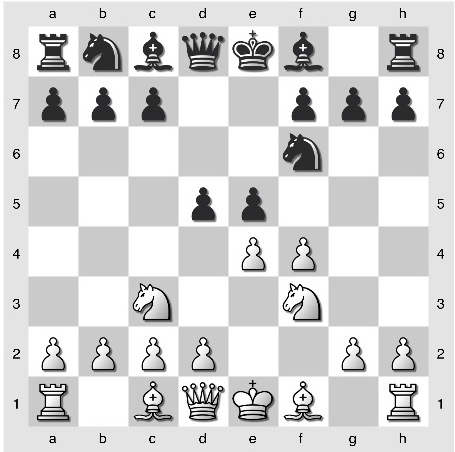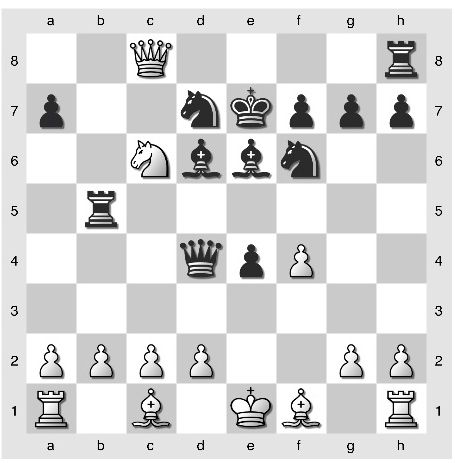Since my last post was about my best game (possibly) against the computer, fairness requires that I now show you my worst game, which I played yesterday. As ghastly as it is, there is still a fascinating train-wreck-in-slow-motion beauty to it.
Shredder — Dana Mackenzie
(40 moves/10 minutes)
1. e4 e5 2. Nc3 Nf6 3. f4 d5 4. Nf3 …
 Position after 4. Nf3. Black to move.
Position after 4. Nf3. Black to move.
One thing that constantly amazes me about the computer is its ability to find holes in my opening knowledge. Here, for instance, humans always play 4. fe. It’s just a given. So when Shredder sprang 4. Nf3 on me — a perfectly reasonable move that has almost never been played before (only 3 times in the chess.com master database) — I had no idea what to do.
Probably best for Black is 4. … ef, when either 5. ed or 5. e5 transpose into perfectly playable variations of the King’s Gambit. That’s one good lesson for me from this game — if the opponent plays something weird, see if you can transpose into something you know.
4. … de 5. Nxe5 Be6?
I was trying to discourage 6. Bc4, but I missed the fact that White’s next move wins a pawn.
6. Qe2! …
Getting in the way of his own development, pawn-hunting with the queen… Nevertheless, computers can get away with this sort of thing.
6. … Qd4? 7. Qb5+ Nbd7 8. Qxb7 Rb8 9. Qxc7 Bd6?
According to Shredder, 9. … Bc5! 10. Nd1 Bb6! and I am still very much in the game, even two pawns down. The main point is that 11. Nc6 is met by 11. … Qc5 12. b4 Qf8! and White’s queen is trapped. Let’s be honest — this is the sort of position that only a computer can play well.
10. Nb5 Rxb5 11. Qc8+ Ke7
… and here I was still daydreaming about my attacking possibilities after 12. Qxh8? Nxe5 when I was rudely awakened by
12. Nc6 mate!
Lessons from this game:
- Always go pawn-hunting with your queen. It’ll be fantastic.
- Don’t bother developing your pieces. Black has developed all of his pieces here; how well did that work out?
If your teacher tries to teach you not to go pawn hunting, or to develop your pieces as rapidly as possible, just show him this game and tell him he’s wrong.




{ 5 comments… read them below or add one }
You wrote:
“one good lesson for me from this game — if the opponent plays something weird, see if you can transpose into something you know.”
At my last chess party, we discussed something similar that happened to me. After 1. e4 e6 2. d3 d5 3. Nd2 c5 4. g3 Nc6 5. Bg7 Nge7 was played by my opponent. I had never seen this move before and didn’t know what to do.
In fact, when surprised by a rare move the percentage of times that I find the right reaction is probably below 50%. It’s one of the biggest weaknesses I have.
I think it would be useful for both of us to try to develop a short list of standard things to do and questions to ask yourself whenever you are confronted with an opening surprise. I’ll bring this up as a topic to discuss at my next chess party.
About the game itself, every now and then I sit down to play chess and my mind just doesn’t function at all. I think that was what happened to you in this game. I always shrug those losses off; they are not related to your chess skill, they are a function of your physical condition.
This game could be a fine example of what John Watson preaches in his book “Modern Chess Strategy – Advances since Nimzowitch”.
Can you be more specific? I haven’t read the book, and I’m sure that there are lots of things in it! One other thing I learned is that walking into a smothered mate in the middle of the board is not such a great idea. But that was known before Nimzovich!
In a recent tournament game I played the Alapin Sicilian, and after 12 or 15 moves was looking in puzzlement at a position very far from my known repertoire. But it seemed oddly familiar–eventually I realized that it was a King’s Indian, which I have never played but know from watching Nakamura videos and thumbing through the chapters in _Pawn Structures._ Turned out that the recipe from _Pawn Structures_ did the trick nicely.
Two tournaments later I had another one, which I also won (less cleanly). Not being a d4 player, these are the only two King’s Indians I have ever played. The Alapin is pretty transpositional, but previously I’d only seen it turn into the French or various odd Sicilians; I had no idea it could become a KID.
If I had the time and determination to study all the chapters of _Pawn Structures_ that *don’t* relate to any of my openings, I bet my play would improve.
I launched an android app at
https://play.google.com/store/apps/details?id=bldg5.jj.pgnbase
It does have a lot of computer games you can study. Key in “Deep Blue” for example.
My blog is at
http://chesspgnhelper.blogspot.com/